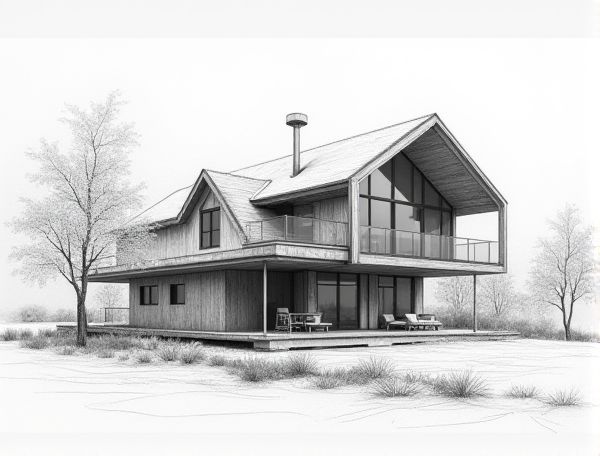
Photo illustration: Biomimetic home design with passive ventilation systems
Biomimetic home design incorporates passive ventilation systems inspired by natural processes to enhance indoor air quality and energy efficiency while reducing reliance on mechanical cooling. Explore how mimicking nature in your home's design can create a healthier, more sustainable living environment by reading more in the article.
Introduction to Biomimetic Home Design
Biomimetic home design integrates natural principles and ecosystems to create sustainable, energy-efficient living spaces that promote wellness and environmental harmony. This approach utilizes materials, structures, and patterns inspired by nature, enhancing functionality while reducing ecological impact.
Understanding Passive Ventilation Systems
Passive ventilation systems rely on natural airflow through strategically placed vents, windows, and openings to regulate indoor air quality without mechanical assistance. Properly designed passive ventilation enhances energy efficiency by reducing the need for electrical cooling and heating, while maintaining comfortable indoor temperatures and moisture control.
Nature-Inspired Ventilation Strategies
Nature-inspired ventilation strategies incorporate principles such as cross-ventilation, stack effect, and wind catching to enhance indoor air quality and thermal comfort while reducing energy consumption. Designing windows and vents based on local wind patterns and sun orientation optimizes natural airflow, promoting passive cooling and minimizing reliance on mechanical HVAC systems. Integrating greenery and water features further aids in cooling and purifying the air, creating a healthier and more sustainable living environment.
Key Benefits of Biomimetic Passive Ventilation
Biomimetic passive ventilation enhances indoor air quality by mimicking natural airflow patterns, reducing reliance on mechanical systems and lowering energy consumption. This sustainable design approach improves thermal comfort, minimizes carbon footprint, and promotes healthier living environments through efficient natural ventilation.
Case Studies: Successful Biomimetic Homes
Biomimetic homes like the Eastgate Centre in Zimbabwe demonstrate energy efficiency by mimicking termite mound ventilation, reducing cooling costs by up to 90%. The Brock Environmental Center in Virginia integrates rainwater harvesting and natural ventilation inspired by local ecosystems, achieving net-zero energy status. Studies reveal that these homes not only lower environmental impact but also enhance occupant comfort through innovative, nature-inspired design strategies.
Design Principles for Biomimetic Ventilation
Biomimetic ventilation in home design harnesses natural airflow patterns inspired by plant and animal systems to enhance indoor air quality and energy efficiency. Your living space benefits from strategic placement of vents and openings that mimic organic structures, promoting sustainable cooling and ventilation without relying heavily on mechanical systems.
Materials and Technologies for Passive Ventilation
Natural materials such as clay, wood, and breathable plaster enhance the effectiveness of passive ventilation by allowing air to flow while regulating indoor humidity levels. Advanced technologies like energy recovery ventilators (ERVs) and smart airflow sensors optimize air circulation and maintain indoor air quality without relying on mechanical systems.
Integrating Biomimetic Design with Modern Architecture
Biomimetic design draws inspiration from nature's efficient structures and ecosystems, enhancing energy efficiency and sustainability in modern architecture. Integrating biomimetic principles with cutting-edge materials and smart technologies creates homes that adapt to environmental conditions, reducing energy consumption and improving indoor comfort. Your home can benefit from this innovative approach by blending natural patterns and systems with contemporary design for a healthier, eco-friendly living space.
Energy Efficiency and Sustainability Impacts
Incorporating energy-efficient appliances and sustainable materials in your home design significantly reduces utility costs and lowers your carbon footprint. Strategic insulation, solar panels, and smart home systems optimize energy use, promoting long-term environmental and economic benefits.
Future Trends in Biomimetic Ventilation Systems
Biomimetic ventilation systems replicate natural airflow patterns found in plants and animals to optimize indoor air quality and energy efficiency. These systems use advanced sensors and adaptive materials to regulate temperature and humidity dynamically, significantly reducing reliance on traditional HVAC units. Incorporating biomimetic ventilation can transform Your home into an eco-friendly space that promotes health and sustainability.
 homedesy.com
homedesy.com